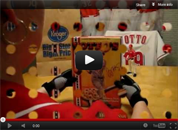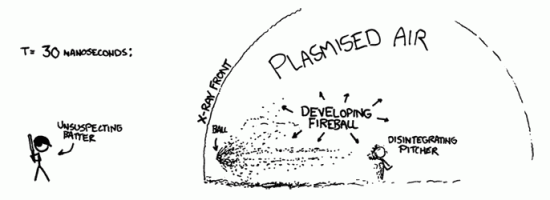XKCD on baseball at the speed of light
And no, this isn’t a post about Cincinnati Reds flamethrower Aroldis Chapman.
Randall Munroe, the guy behind the web comic XKCD, has launched a new weekly feature where he will answer science questions submitted by readers. Today’s–the first one–just so happens to focus on baseball.
What would happen if you tried to hit a baseball pitched at 90% the speed of light?
Typically, hypothetical questions like this are first responded to by how impossible something like that is. To his credit Munroe decides to skip over that and actually answer the question, and it’s an entertaining read.
The ideas of aerodynamics don’t apply here. Normally, air would flow around anything moving through it. But the air molecules in front of this ball don’t have time to be jostled out of the way. The ball smacks into them hard that the atoms in the air molecules actually fuse with the atoms in the ball’s surface. Each collision releases a burst of gamma rays and scattered particles.
These gamma rays and debris expand outward in a bubble centered on the pitcher’s mound. They start to tear apart the molecules in the air, ripping the electrons from the nuclei and turning the air in the stadium into an expanding bubble of incandescent plasma. The wall of this bubble approaches the batter at about the speed of light—only slightly ahead of the ball itself.
That does not sound or look good, and it wouldn’t be. The results would be catastrophic. Read the whole thing, and be sure to stick around for the footnote.
If you’re a fan of XKCD, you might also be interested in this comic I made a few years back.



